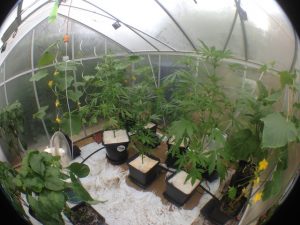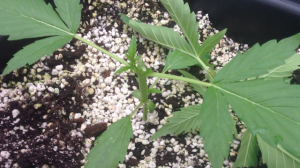Summers in northern Europe can be soggy affairs. June 2016 in Belgium was the wettest on record. The rest of the summer had high humidity and cooler than average temperatures. Not ideal conditions for growing cannabis plants, even if they are sheltered in a greenhouse.
The growing of one cannabis plant per adult is decriminalised in Belgium. I consume cannabis for nobody’s business but my own, and grow it because I enjoy it.
Over the summer I was growing on behalf of a few friends who had each signed a letter stating they were a responsible adult who owned one of the plants.
This grow had a particular challenge. I had a month long holiday booked for August, right around the time the plants would be flowering. What could possibly go wrong?
I set up an automated watering system, from UK based AutoPot, which keeps the plants watered thanks to a reservoir, gravity, a bunch of hoses and a clever blue valve which sits in the tray of each pot.
This was an organic grow, so as long as the soil is good it should see the plants through without having to provide additional nutrients. I used BioTabs and followed their instructions for bringing my organic Plagron Royale Mix to life. Any good organic substrate will do and can be found at your local grow shop. I added one third extra of perlite to keep it airy, which is good for the roots. They say “more root equals more fruit”.
The plants were all autoflowering strains, which meant I did not have to rely on the change in light to initiate flowering (the buds you dry and smoke). They are smaller than regular cannabis plants, and when stressed they can sometimes hermaphrodite. Autoflowering plants are generally regarded as plants for casual or hobby growers. Once you get the knack of them they are an easy way to have home-grown cannabis; just like brewing at home gives you cheap booze.
Autoflowering plants also tend to be lower in THC than the strains you get from your dealer. Combine this with a higher CBD than average and you get a well-rounded high which is less likely to leave you feeling all jittery and paranoid. Think of it as having a beer versus a shot of tequila.
I was growing Think Different, Auto Night Queen, Auto Colorado Cookies, Auto Blackberry Kush and Blue Automazar from Dutch Passion, who are about to celebrate 30 years in the industry.
The sixth plant came from newcomer, Heavyweight Seeds, and went by the descriptive name of Vast and Fast, a skunky little number with a quick finishing time.
Not all of them survived.

On the first of May I germinated my seeds in 10 cm pots within the substrate they would grow in under 2x55W neon lights which were on 18 hours a day. Neons don’t get hot so it’s fine to position the light around 20 cm above the seeds. I didn’t go for any fancy germination techniques and left mother nature to do what she does best. I planted three of each strain, 18 in total.
I wasn’t just going to grow “therapeutic herbs” in my greenhouse. I was also growing food, so I had a total of 13 pots; twelve 15 litre pots and one twenty-five litre pot. I wanted to see if pot size made a difference in the yield. Spoiler: no not really, save your money, space and back and go for the 15 litre ones.
Thirteen plants were growing in a 3.5m x 3.8m greenhouse. This was my first big mistake. The water needed to grow all these plants increased the humidity a lot. Humidity leads to moulds. There is no way to rescue a rotten bud just like there is no way to rescue a rotten apple. I won’t spoil the story but if done again, I’d probably grow four autoflowering plants in 15 litre AutoPots and forego the fruit and veg.

I poured in five centimetres of expanded clay pellets into the bottom of each pot. In a large tray I mixed up the substrate and added the necessary BioTab additions (they all came in a starter pack with instructions). These get the beneficial microbes going in the organic matter. I put it all in the pots and added one and half BioTabs (broken in halves) five centimetres or so below where the plant would be.
If you are thinking of doing a similar project make sure you have enough of all the nutrients and substrate before you start the grow. I didn’t and had a mad rush tracking down the right ingredients in a race against time as the seedlings were rapidly outgrowing the pots they were planted in.
Autoflowering has an interesting trait. Once the seed germinates, a tap root is sent down to figure out how much space the plant has to grow in. Once this tap root hits an obstacle it sends a message to the rest of the plant to stop growing and start flowering. It’s a genetic thing. Ruderalis, the species of cannabis that gives autoflowering plants their autoflowering property, normally grows in harsh conditions so doesn’t waste time in vegetative growth when there is flowering to be done before winter.
I filled up my 300 litre water tank with tap water and left it for a day to allow the chlorine to evaporate.
Meanwhile, in the germination space, I had 18 bushy baby plants waiting for a home. It was now mid-May, a time when — traditionally — there is no more chance of frost.
I put them, still in their original pots, in a shady part of the greenhouse to acclimatise. Moving or repotting the plants both result in stress so it’s best to take things slow and not make too many radical changes at once.

The plants had toughened up thanks to the change in temperature and the solar powered fans that were in place to improve the airflow.
It was time to transplant. I chose the strongest of each of the strains and composted the rest. I watered the plants and left them to fend for themselves. It was now June. It started to pour down and did so for the next four weeks.
Slugs lay many eggs which lie dormant in the soil until the spring arrives. Thanks to a mild winter, the majority of these eggs survived and hatched. The hungry baby slugs then descended on my greenhouse.
If I had a two centimetre thick layer of perlite over the surface of the substrate I probably would have stopped them. If I had protective transparent domes over the pots that would’ve helped too.

I had neither and after a month’s growth, I lost my first plant before it got a chance to flower. My Vast and Fast from Heavyweight Seeds had been knocked out. I hastily popped the two remaining seeds into the pot and hoped for the best. As it turned out, one germinated and the densely budded plant finished around the same time as the others. I can testify the name is no lie.
Up until flowering, I sprayed the plants periodically with neem oil, an organic pesticide, and Boom Boom spray, a bio foliage nutrient from BioTabs. As for my tank, the watering was taken care of. This setup didn’t require any pH adjustments so my only job was to keep an eye out for pests and diseases.
The plants grew big and it was not long before they were approaching the roof. I trained them by gently rubbing the stems to make them flop over. It looked drastic at the time but they soon bounced back. You can produce an even canopy with this technique and have multiple flowering tops. Bear in mind this can damage the stem and weaken the plant, making it susceptible to disease. Only do it when absolutely necessary.
As the plants flowered, the humidity levels were too high. The constant rain kept it a steady 90%; it should have been no higher than 60%. Despite two large oscillating fans running 24 hours a day, I was unable to stem outbreaks of bud rot.
I lost my second plant.
The Auto Night Queen had had enough of the uncomfortable situation and decided she wanted to be a man. I had to pull her (fast becoming him) before s/he pollinated the rest of the garden. It was already flowering so I baked the buds in the oven for 30 minutes to rapid dry and decarboxylate. I stored them in a jar without having to worry about drying the buds which freed me to concentrate on the rest of the grow. I made some cannabis infused olive oil with these at a later date.
The humidity was taking it’s toll. Searching for, removing and destroying rotten buds was a daily task. My holiday was fast approaching and all the plants were flowering heavily.

I harvested two of the plants. The big fat buds on the Blue Automazar and the Auto Colorado Cookies were almost fully ripe and showing the most signs of bud rot. The Blue Mazar had to be destroyed due to mould. I managed to save two thirds of the Colorado Cookies which I left to dry on a hanging drying rack after removing the fan leaves. I kept the trichome covered sugar leaves for processing into hash at a later date.
Then I filled up the water tank, set off to Southeast Asia for a month and hoped for the best.
I had three concerns… Number one, the authorities would intervene and remove the crop. It would be annoying but unlikely to land me in any serious trouble. Number two, I would run out of water (thankfully, I didn’t). And the third worry was that bud rot would wipe out the garden. This was the most likely and, true enough, on my return my magnificent purple Auto Blackberry Kush was completely lost to mould. I was gutted. Had I been around I would have been able to harvest a bumper crop.

The Think Different and Vast and Fast also had signs of bud rot but were salvageable. Thanks to the sativa genetics of the Think Different, the buds are not as dense meaning there were less dank nugs for moulds to fester within. The others were all indica dominant, whose buds are generally denser. I lost about one fifth of the Think Different and around half of the Vast and Fast.
In the end, the yield wasn’t that great. Before taking bud rot into account each plants would have averaged around 60 grams, even more in the case of the heavily laden Blackberry Kush (sob). Needless to say, I didn’t get that. My friends and I are not the largest consumers of cannabis in the world so are satisfied enough to give it another go.
If I were to do it again, I would start the grow later to avoid the common mid-summer rains — thanks in large part to global warming. Ironically, some of increased carbon dioxide in the atmosphere comes from producing the electricity that people use to grow indoors to avoid the crappy weather.
One more thing, I wouldn’t recommend leaving the garden for more than one week unattended.







i had heard people are using a nano water of some kind, or preprogrammed liquid, so i had the rainbow kushnano weed in rotterdam, which was amazing, it was made from the above. they sell it in Netherlands, but with this liquid is amazing its just like water. and the weed was grown outdoor with that. will try and let you know the results.